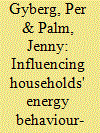| Srl | Item |
| 1 |
ID:
125772


|
|
|
|
|
| Publication |
2013.
|
| Summary/Abstract |
People building their own houses have, at least theoretically, substantial autonomy when choosing, for example, a heating system and windows. In this article, focus is on the process of building new single-family houses and how energy efficiency and energy-efficient technology are incorporated into the building process. The conclusions emphasize energy as only one factor in housing purchase decisions. It is a big challenge to make low-energy building important to consumers. Consumer preferences for new products are unlikely to fully develop unless individuals have the opportunity to interact with them. It is difficult for consumers to know what to ask for if they lack experience of energy-efficient technologies. In the studied cases, the building codes and established standards became extremely decisive for how energy issues were included in the process. There is a need to change the design of incentives so as to make the least energy-efficient choice the most expensive. The most energy-efficient solution should be standard, and if the buyer wants to depart from that standard and build using less energy-efficient construction, then that should cost more.
|
|
|
|
|
|
|
|
|
|
|
|
|
|
|
|
| 2 |
ID:
116954


|
|
|
|
|
| Publication |
2012.
|
| Summary/Abstract |
In order to reach the EU: s 20-20-20 primary energy savings target, energy efficiency needs to increase. Previous research on energy use and energy efficiency has focused mainly on the diffusion of energy efficient technologies. The discrepancy between optimal and actual implementation of energy efficient technologies has been illustrated in numerous articles and is often referred to as the energy efficiency gap. However, efficient technologies are not the only ways to increase energy efficiency. Empirical studies have found that a cost-effective way to improve energy efficiency is to combine investments in energy-efficient technologies with continuous energy management practices. By including energy management into an estimated energy efficiency potential this paper introduces an extended energy efficiency gap, mainly in manufacturing industries and the commercial sector. The inclusion of energy management components in future energy policy will play an important role if the energy savings targets for 2020, and later 2050, are to be met in the EU.
|
|
|
|
|
|
|
|
|
|
|
|
|
|
|
|
| 3 |
ID:
088282


|
|
|
|
|
| Publication |
2009.
|
| Summary/Abstract |
This article examines the discourse that the idea of efficiency is built upon according to different actors trying to influence households' energy behaviour in Sweden. The focus is on information from authorities as well as from interest organisations and energy companies. Information directed to households often contains a strong idea that the individual has to take responsibility for his/her own choices, and that it is through consumer choices the energy system will become more sustainable. The reasons given for changing one's behaviour are motivated both by lower energy costs and a reduced impact on the environment. Common advice for energy reduction is to change to a more energy-efficient apparatus. In this sense efficiency is a way of not changing lifestyle but instead changing technical equipment and user routines. Only the LA21 project questions the need for all the apparatus as well as the possibility to improve existing artifacts, pointing to a need to change our lifestyle. The strong belief in science and technology results in a definition of the problem as a lack of knowledge, where the only solution is to fill this gap.
|
|
|
|
|
|
|
|
|
|
|
|
|
|
|
|
| 4 |
ID:
096111


|
|
|
|
|
| Publication |
2010.
|
| Summary/Abstract |
Environmental problems in the energy system often originate from everyday activities and choices. Everyday activities in the home are part of the private sphere that can be contested in relation to energy policies. This article discusses the public-private divide in energy policies and how Swedish municipal energy consultants understand the divide. By analyzing the actions of energy consultants and their efforts to influence households, as well as how households perceive this guidance, I will discuss the public-private discourse in relation to energy policy and how this discourse can be a restriction for the energy consultants to reach their full potential.
The consultants found it problematic to discuss behavioral issues because they did not know how to relate to people's everyday life activities without intruding on private and personal matters. For the households tailored information and feedback was not perceived as the consultant trespassing in the private sphere. Instead, the householders highlight the possibilities of such mapping. Lessoned learned from Sweden is that state subsidies to local energy consultants is a good way to reach households, but that they need to develop their methods and use more tailored information.
|
|
|
|
|
|
|
|
|
|
|
|
|
|
|
|